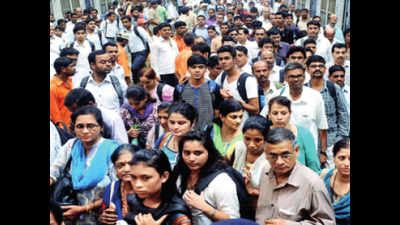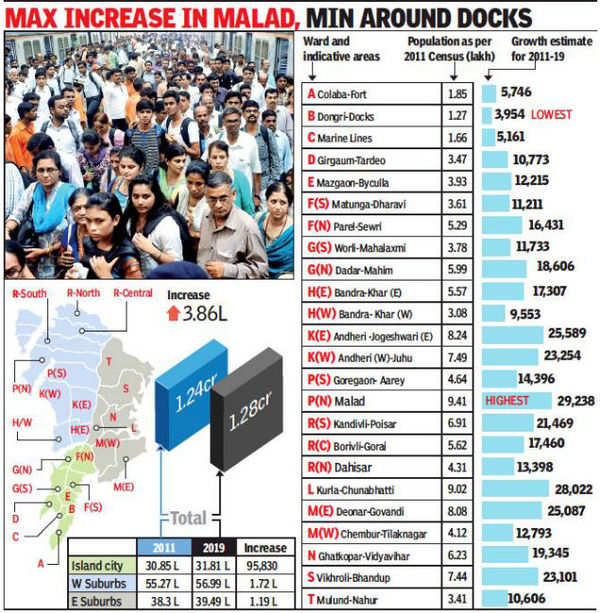- News
- City News
- mumbai News
- BMC estimates 4 lakh population rise since 2011 to plan amenities for Mumbai
Trending
This story is from August 19, 2019
BMC estimates 4 lakh population rise since 2011 to plan amenities for Mumbai
Ahead of the 2021 census, for which BMC will undertake a door-to-door survey, the civic body has arrived at a current population estimate to better distribute municipal services and resources. In the eight years since the 2011 census, Mumbai’s population is estimated to have grown by almost 4 lakh to 1.28 crore.

In the eight years since the 2011 census, Mumbai’s population is estimated to have grown by almost 4 lakh to 1.28 crore
Ahead of the 2021 census, for which BMC will undertake a door-to-door survey, the civic body has arrived at a current population estimate to better distribute municipal services and resources. In the eight years since the 2011 census, Mumbai’s population is estimated to have grown by almost 4 lakh to 1.28 crore.
“The 2021 census is two years away, and its results will take even more time to come.We can’t wait that long to decide on civic infrastructure ward-wise. BMC’s health department therefore periodically carries out population estimates for Mumbai’s 24 wards,” said a civic official.

The estimates are a mathematical projection based on the 2011 census. Since the city’s population grew at a rate of 0.38% per year (compounded annual growth rate, or CAGR) in the 2001-11 census decade, BMC applied a similar rate of growth for the current decade to arrive at the estimates, whereby, population in the island city has grown by 0.95 lakh, in the western suburbs by 1.7 lakh and in the eastern suburbs by 1.2 lakh. At the ward level, the highest growth, 29,238, has been in the congested P North ward (Malad area), while the lowest, 3,954, has been in the largely dockland B ward (Sandhurst Road area). In fact, BMC’s use of a uniform CAGR across the city shows an interesting trend: the island city, which had shown a decline in population as per previous estimates, is now showing a return of people.
Nevertheless, enumeration is not without problems. For example, BMC’s internal slum population figures for 2011 are at variance with the census. “But the population total for the city is the same in both cases. So, why do BMC figures show higher slum populations?” asks a civic official before furnishing the answer: “Well, it’s no secret that slum figures are inflated because of pressure from politicians, so that more local staff can be hired for soild waste roles than allowed under civic rules. On the other hand, the census, conducted door-to-door, is purely statistical.”
Elaborating on the strategy for amenities, an official explained that every civic department has a certain norm on the quantum of service to be provided to each citizen. For instance, a citizen is now entitled to 135 litres of water per day; when a building plan is submitted, it is assumed that there are five persons to a tenement, and BMC commits to provide the required quantity of water depending on the number of tenements. Of course, to ensure that services reach the wards as planned, there’s a mechanism whereby corporators provide regular feedback to the administration. But then very often, these look good only on paper. As citizen activists have often said, plans are great only if they are implemented.
“The 2021 census is two years away, and its results will take even more time to come.We can’t wait that long to decide on civic infrastructure ward-wise. BMC’s health department therefore periodically carries out population estimates for Mumbai’s 24 wards,” said a civic official.

The estimates are a mathematical projection based on the 2011 census. Since the city’s population grew at a rate of 0.38% per year (compounded annual growth rate, or CAGR) in the 2001-11 census decade, BMC applied a similar rate of growth for the current decade to arrive at the estimates, whereby, population in the island city has grown by 0.95 lakh, in the western suburbs by 1.7 lakh and in the eastern suburbs by 1.2 lakh. At the ward level, the highest growth, 29,238, has been in the congested P North ward (Malad area), while the lowest, 3,954, has been in the largely dockland B ward (Sandhurst Road area). In fact, BMC’s use of a uniform CAGR across the city shows an interesting trend: the island city, which had shown a decline in population as per previous estimates, is now showing a return of people.
Incidentally, Development Plan (DP) 2034 assumed a population of 1.28 crore by 2021—the same as the BMC's 2019 estimate, showing that the projected population has already been reached. However, DP-34 also projects population declines—to 1.19 crore by 2031 and 1.14 crore by 2034. “Every DP is prepared taking a 20-year projection to get the big picture. Land is then reserved for civic amenities like playgrounds, schools, markets and crematoria, and also for things like laying water and sewage pipelines,” said an official.
Nevertheless, enumeration is not without problems. For example, BMC’s internal slum population figures for 2011 are at variance with the census. “But the population total for the city is the same in both cases. So, why do BMC figures show higher slum populations?” asks a civic official before furnishing the answer: “Well, it’s no secret that slum figures are inflated because of pressure from politicians, so that more local staff can be hired for soild waste roles than allowed under civic rules. On the other hand, the census, conducted door-to-door, is purely statistical.”
Elaborating on the strategy for amenities, an official explained that every civic department has a certain norm on the quantum of service to be provided to each citizen. For instance, a citizen is now entitled to 135 litres of water per day; when a building plan is submitted, it is assumed that there are five persons to a tenement, and BMC commits to provide the required quantity of water depending on the number of tenements. Of course, to ensure that services reach the wards as planned, there’s a mechanism whereby corporators provide regular feedback to the administration. But then very often, these look good only on paper. As citizen activists have often said, plans are great only if they are implemented.
End of Article
FOLLOW US ON SOCIAL MEDIA










